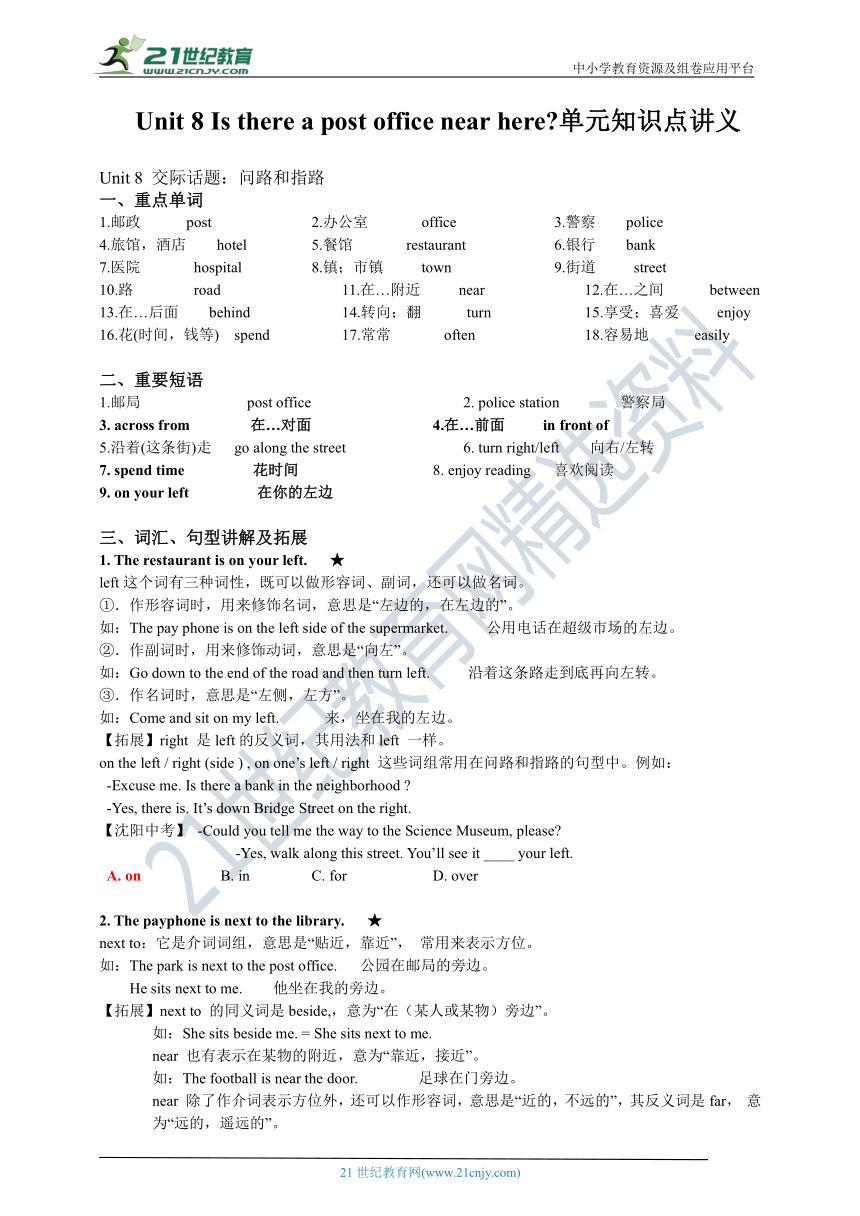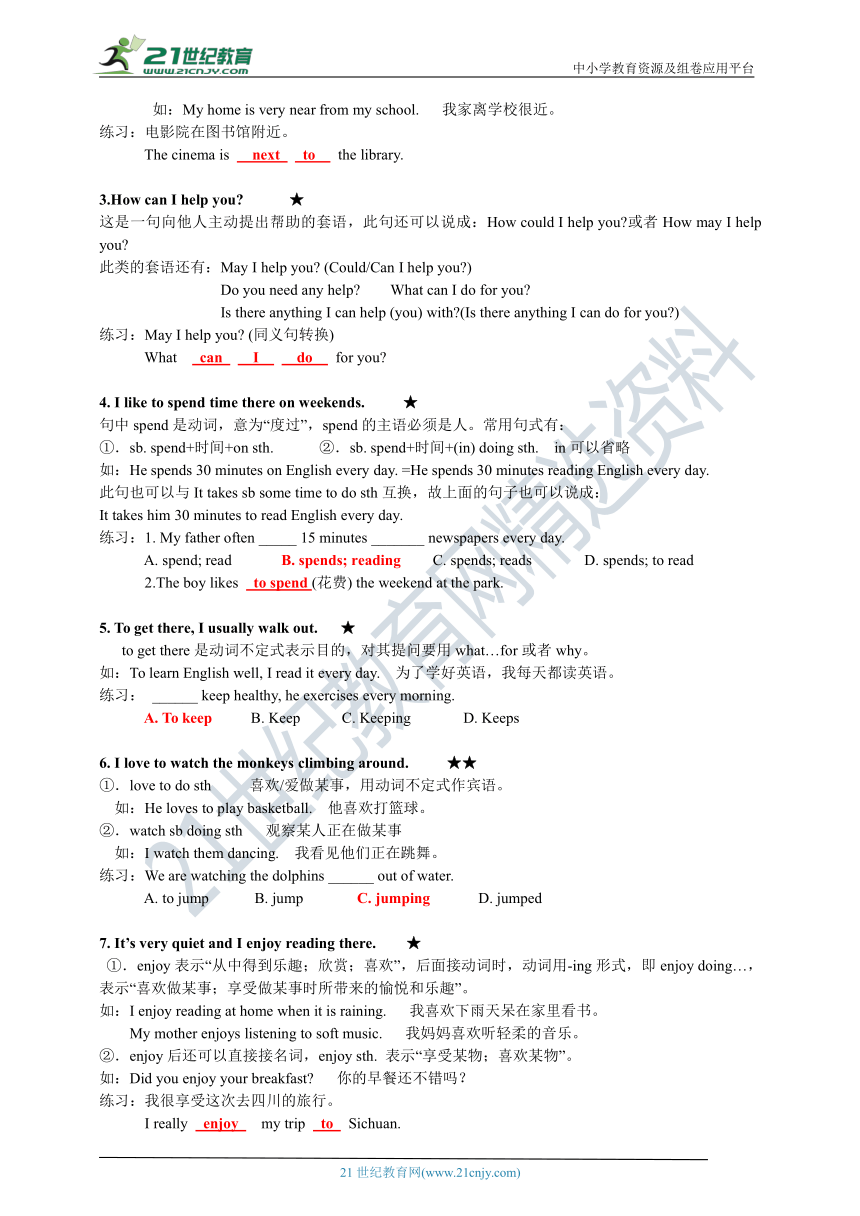Unit 8 Is there a post office near here? 单元知识点讲义
文档属性
| 名称 | Unit 8 Is there a post office near here? 单元知识点讲义 |  | |
| 格式 | zip | ||
| 文件大小 | 1.2MB | ||
| 资源类型 | 试卷 | ||
| 版本资源 | 人教新目标(Go for it)版 | ||
| 科目 | 英语 | ||
| 更新时间 | 2020-02-05 16:11:17 | ||
图片预览


文档简介
中小学教育资源及组卷应用平台
Unit 8 Is there a post office near here?单元知识点讲义
Unit 8 交际话题:问路和指路
一、重点单词
1.邮政 post 2.办公室 office 3.警察 police
4.旅馆,酒店 hotel 5.餐馆 restaurant 6.银行 bank
7.医院 hospital 8.镇;市镇 town 9.街道 street
10.路 road 11.在…附近 near 12.在…之间 between
13.在…后面 behind 14.转向;翻 turn 15.享受;喜爱 enjoy
16.花(时间,钱等) spend 17.常常 often 18.容易地 easily
二、重要短语
1.邮局 post office 2. police station 警察局
3. across from 在…对面 4.在…前面 in front of
5.沿着(这条街)走 go along the street 6. turn right/left 向右/左转
7. spend time 花时间 8. enjoy reading 喜欢阅读
9. on your left 在你的左边
三、词汇、句型讲解及拓展
1. The restaurant is on your left. ★
left这个词有三种词性,既可以做形容词、副词,还可以做名词。
①.作形容词时,用来修饰名词,意思是“左边的,在左边的”。
如:The pay phone is on the left side of the supermarket. 公用电话在超级市场的左边。
②.作副词时,用来修饰动词,意思是“向左”。
如:Go down to the end of the road and then turn left. 沿着这条路走到底再向左转。
③.作名词时,意思是“左侧,左方”。
如:Come and sit on my left. 来,坐在我的左边。
【拓展】right 是left的反义词,其用法和left 一样。
on the left / right (side ) , on one’s left / right 这些词组常用在问路和指路的句型中。例如:
-Excuse me. Is there a bank in the neighborhood ?
-Yes, there is. It’s down Bridge Street on the right.
【沈阳中考】 -Could you tell me the way to the Science Museum, please?
-Yes, walk along this street. You’ll see it ____ your left.
A. on B. in C. for D. over
2. The payphone is next to the library. ★
next to:它是介词词组,意思是“贴近,靠近”, 常用来表示方位。
如:The park is next to the post office. 公园在邮局的旁边。
He sits next to me. 他坐在我的旁边。
【拓展】next to 的同义词是beside,,意为“在(某人或某物)旁边”。
如:She sits beside me. = She sits next to me.
near 也有表示在某物的附近,意为“靠近,接近”。
如:The football is near the door. 足球在门旁边。
near 除了作介词表示方位外,还可以作形容词,意思是“近的,不远的”,其反义词是far, 意为“远的,遥远的”。
如:My home is very near from my school. 我家离学校很近。
练习:电影院在图书馆附近。
The cinema is next to the library.
3.How can I help you? ★
这是一句向他人主动提出帮助的套语,此句还可以说成:How could I help you?或者How may I help you?
此类的套语还有:May I help you? (Could/Can I help you?)
Do you need any help? What can I do for you?
Is there anything I can help (you) with?(Is there anything I can do for you?)
练习:May I help you? (同义句转换)
What can I do for you?
4. I like to spend time there on weekends. ★
句中spend是动词,意为“度过”,spend的主语必须是人。常用句式有:
①.sb. spend+时间+on sth. ②.sb. spend+时间+(in) doing sth. in可以省略
如:He spends 30 minutes on English every day. =He spends 30 minutes reading English every day.
此句也可以与It takes sb some time to do sth互换,故上面的句子也可以说成:
It takes him 30 minutes to read English every day.
练习:1. My father often _____ 15 minutes _______ newspapers every day.
A. spend; read B. spends; reading C. spends; reads D. spends; to read
2.The boy likes to spend (花费) the weekend at the park.
5. To get there, I usually walk out. ★
to get there是动词不定式表示目的,对其提问要用what…for或者why。
如:To learn English well, I read it every day. 为了学好英语,我每天都读英语。
练习: ______ keep healthy, he exercises every morning.
A. To keep B. Keep C. Keeping D. Keeps
6. I love to watch the monkeys climbing around. ★★
①.love to do sth 喜欢/爱做某事,用动词不定式作宾语。
如:He loves to play basketball. 他喜欢打篮球。
②.watch sb doing sth 观察某人正在做某事
如:I watch them dancing. 我看见他们正在跳舞。
练习:We are watching the dolphins ______ out of water.
A. to jump B. jump C. jumping D. jumped
7. It’s very quiet and I enjoy reading there. ★
①.enjoy表示“从中得到乐趣;欣赏;喜欢”,后面接动词时,动词用-ing形式,即enjoy doing…,表示“喜欢做某事;享受做某事时所带来的愉悦和乐趣”。
如:I enjoy reading at home when it is raining. 我喜欢下雨天呆在家里看书。
My mother enjoys listening to soft music. 我妈妈喜欢听轻柔的音乐。
②.enjoy后还可以直接接名词,enjoy sth. 表示“享受某物;喜欢某物”。
如:Did you enjoy your breakfast? 你的早餐还不错吗?
练习:我很享受这次去四川的旅行。
I really enjoy my trip to Sichuan.
四、语法专项
1.There be句型的用法
①.构成:There be ...句型表示的是“某处有(存在)某人或某物”,
其结构为There be(is,are,was, were)+名词+地点状语。
如:There are fifty-two students in our class. There is a pencil in my pencil-case.
②.各种句式:
1).否定句:在be后加上“not”,也可用“no”来表示。
即:no + n.(名词)= not a\an\any + n.(名词)。
注意:no + n.(可数名词单数)= not a\an + n.(可数名词单数);no + n.(可数名词复数)
如:There is an orange in her bag.=There isn’t an orange in her bag.=There is no orange in her bag.
2).一般疑问句:be动词移到句首,再在句尾加上问号。
如:There is some money in her handbag. → Is there any money in her handbag?
(疑问句和否定句中,some改为any, something改为anything.)
3).特殊疑问句
【注意事项】:
There be句型中be动词的形式要和其后的主语在人称和数上保持一致。
①.如果句子的主语是单数的可数名词,或是不可数名词,be动词用“is”“was”。
如:There is a basketball in the box. There is a little milk in the glass.
②.如果句子的主语是复数名词,be动词就用“are” “were”。
如:There are many birds in the tree. There were many people in the street yesterday.
③.如果有两个或两个以上的名词作主语,be动词要和最靠近它的那个主语在数上保持一致,也就是我们常说的 “就近原则”。例如:
There is an orange and some bananas in the basket.
There are some bananas and an orange in the basket.
1.【河北中考】 ______ something wrong with my bike. Can I use yours?
A. It is B. It was C. There is D. There was
2.【福建中考】-Leo, ____ no milk or eggs in the fridge.
-Oh, I’ll go and buy some right away.
A. it is B. there is C. there are D. they are
3.用适当的be动词填空:
1).There is a girl, a boy and two women in the room.
2). - Are there any post offices in your city?
-Yes, there are .
2. Where引导的特殊疑问句
-Where is the hotel? -It’s behind the police station.
问句是一个由where引导的特殊疑问句,提问地点。回答时直接表明方位。
关于指路的表达方式常见的有:
①.Walk/ Go along/ up/ down… road/ street 沿着…路/街往前走
②.Turn left/ right at the… crossing=Take the … crossing on the left/ right 在第...路口向左/右转
③.Go cross the bridge. 走过桥
④.Go on until you reach the … 一直走到…
⑤.It’s between the … and the… 它在…和…之间
⑥.It’s next to/ near the … 它紧接着/靠近…
⑦.You’ll see it in front of you. 你会看见它就在你前面。
⑧.It’s on your left/ right hand/ side. 它就在你左/右手边。
⑨.It’s far from here. You can take No…bus. 离这儿很远。你可以乘坐…路公交车。
1.【2017天津】The workers will build a new railroad ____ the two cities.
A. since B. between C. as D. during
2. _____ right at the first ______.
A. Take; turn B. Turn; crossing C. Cross; turn D. Turn; cross
3.它离这儿不远,我可以和你一起步行。
It isn’t far from here, I can walk with you.
4. The supermarket is between the bookshop and the library.(改为同义句)
The bookshop and the library are next to the supermarket.
3.辨析方位短语across from…,next to,between… and…,in front of ★
①.across from… 意为“在…对面”,后面接表地点的名词或代词。
如:Across from the shop is a hotel. 商店对面是个酒店。
②.next to…意为“在…旁边”,后接表地点的名词或代词,可用close to替换。
如:There is a bookshop next to the police station. 警察局旁边有个书店。
③.between…and… 意为“在…和…之间”,连接两个并列成分,可以指时间,也可以指地点。
如:Mike is sitting between Harry and Jim. 迈克坐在哈里和吉姆之间。
④.in front of “在…的前面”,指在一个地方的范围之外的前面。
如:The park is in front of the bank. 公园在银行的前面。
练习:1.付费电话在图书馆对面,银行旁边。
The pay phone is across from the library and next to the bank.
2. The library is behind the train station.(改为同义句)
The train station is in front of the library.
3. – What do you often do _____ classes? -Listen to music.
A. on B. across from C. between D. in
4.【广东中考】-Why are you standing here, Alice?
-I can’t see the blackboard clearly. Two tall boys are sitting ____me.
A. behind B. next to C. between D. in front of
HYPERLINK "http://21世纪教育网(www.21cnjy.com)
" 21世纪教育网(www.21cnjy.com)
同课章节目录
- Unit 1 Can you play the guitar?
- Section A
- Section B
- Unit 2 What time do you go to school?
- Section A
- Section B
- Unit 3 How do you get to school?
- Section A
- Section B
- Unit 4 Don't eat in class.
- Section A
- Section B
- Unit 5 Why do you like pandas?
- Section A
- Section B
- Unit 6 I'm watching TV.
- Section A
- Section B
- Review of Units 1-6
- Unit 7 It's raining!
- Section A
- Section B
- Unit 8 Is there a post office near here?
- Section A
- Section B
- Unit 9 What does he look like?
- Section A
- Section B
- Unit 10 I'd like some noodles.
- Section A
- Section B
- Unit 11 How was your school trip?
- Section A
- Section B
- Unit 12 What did you do last weekend?
- Section A
- Section B
